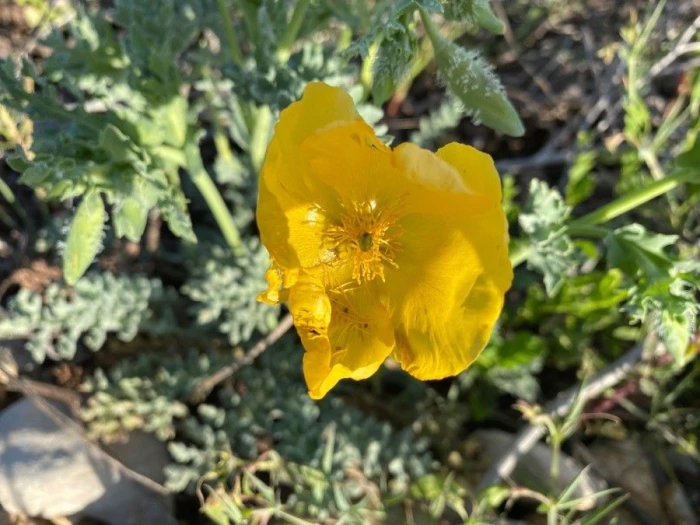Yellow Hornpoppy
(Glaucium flavum)
Yellow Hornpoppy (Glaucium flavum)
/
/

Michel DOUTRE
CC BY-SA 4.0
Image By:
Michel DOUTRE
Recorded By:
Copyright:
CC BY-SA 4.0
Copyright Notice:
Photo by: Michel DOUTRE | License Type: CC BY-SA 4.0 | License URL: https://creativecommons.org/licenses/by-sa/4.0/ | Attribution: Michel DOUTRE (cc-by-sa) | Rights Holder: Michel DOUTRE | Publisher: PlantNet | Date Created: 2020-04-29T17:14:24.845Z | Title: Glaucium flavum Crantz: flower | Notes: |

















































Estimated Native Range
Climate Requirements for Watsonville, California
| This Plant | Your Site | Plant Suitability for Your Location | ||
|---|---|---|---|---|
| • Precipitation | 4" - 167" | 22" | Your precipitation may be insufficient for this plant. Irrigate N" / year. | Irrigate N" / year |
| • High Temp. | -38°F - 101°F | 77°F | Your summer temperatures are normal for this plant. | Excellent |
| • Low Temp. | -79°F - 59°F | 39°F | Your winter temperatures are normal for this plant | Excellent |
This plant should grow well at your location with about N inches per year (Y minutes per month) of irrigation.
Summary
Glaucium flavum, commonly known as Yellow Hornpoppy, is an evergreen biennial herb native to coastal habitats, including sandy beaches, shingle beaches, and sea cliffs in the Mediterranean, North Africa, and Western Asia. This plant typically grows to a height of 30-60 cm (12-24 inches) and spreads 30-60 cm (12-24 inches) wide. The foliage consists of thick, leathery, deeply segmented, wavy, bluish-grey leaves coated in a water-retaining wax, which helps the plant conserve moisture in its arid native habitat.
The Yellow Hornpoppy is known for its showy, bright yellow or orange flowers, each 7.5 cm (3 in) across, which bloom in summer between June and October. Following the flowering period, it produces a very long, upright, thin, distinctive horn-shaped capsule, which is 15–30 cm (6–12 in) long and splits open to reveal seeds. This plant is valued for its drought tolerance and striking flowers, making it suitable for rock gardens, coastal gardens, and xeriscaping. It thrives in full sun and well-drained soils, tolerating low to medium water conditions. While it is not commonly afflicted by diseases, it can become invasive outside its native range, so gardeners should check local regulations before planting.CC BY-SA 4.0
The Yellow Hornpoppy is known for its showy, bright yellow or orange flowers, each 7.5 cm (3 in) across, which bloom in summer between June and October. Following the flowering period, it produces a very long, upright, thin, distinctive horn-shaped capsule, which is 15–30 cm (6–12 in) long and splits open to reveal seeds. This plant is valued for its drought tolerance and striking flowers, making it suitable for rock gardens, coastal gardens, and xeriscaping. It thrives in full sun and well-drained soils, tolerating low to medium water conditions. While it is not commonly afflicted by diseases, it can become invasive outside its native range, so gardeners should check local regulations before planting.CC BY-SA 4.0
Plant Description
- Plant Type: Herb
- Height: 1-2 feet
- Width: 0.5-1 feet
- Growth Rate: Slow
- Flower Color: Yellow
- Flowering Season: Summer, Fall
- Leaf Retention: Evergreen
Growth Requirements
- Sun: Full Sun
- Water: Low, Medium
- Drainage: Medium
Common Uses
Border Plant, Deer Resistant, Drought Tolerant, Low Maintenance, Rabbit Resistant, Salt Tolerant, Showy Flowers
Natural Habitat
Native to coastal habitats, including sandy beaches, shingle beaches, and sea cliffs
Other Names
Common Names: Yellow Horned-Poppy, Horned-Poppy, Sea-Poppy, Strand-Hornskulpe, Gelber Hornmohn, Glaucie Jaune, Glaucienne Jaune, Glaucière Jaune, Pavot Cornu, Pavot Jaune Des Sables
Scientific Names: Glaucium flavum, Glaucium corniculatum var. tricolor, Glaucium luteum, Chelidonium glaucium, Glaucium glaucium, Glaucium fischeri, Glaucium fulvum, Glaucium serpieri, Chelidonium glaucum
GBIF Accepted Name: Glaucium flavum Crantz